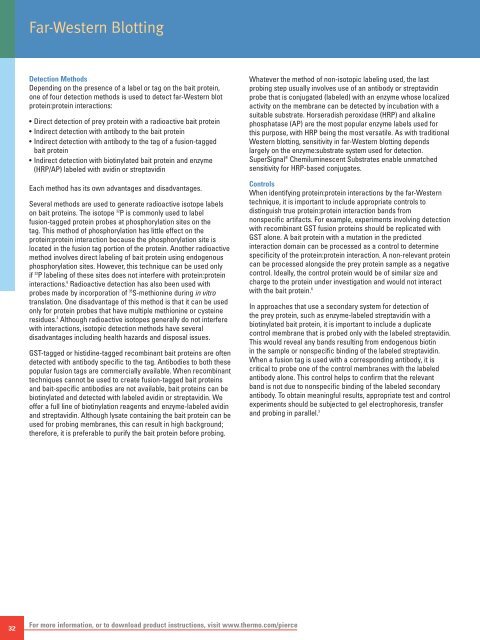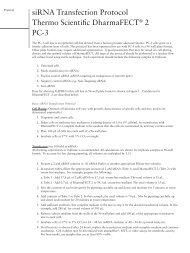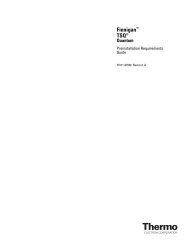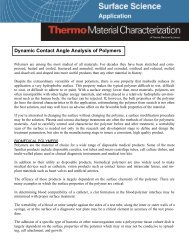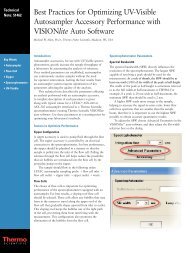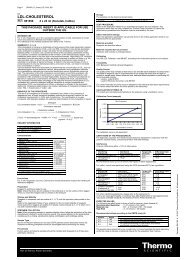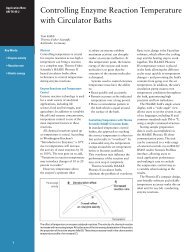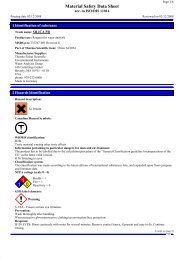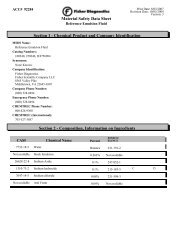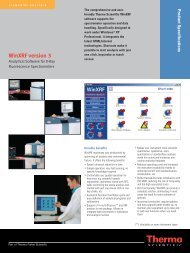Thermo Scientific Pierce Protein Interaction Technical Handbook
Thermo Scientific Pierce Protein Interaction Technical Handbook
Thermo Scientific Pierce Protein Interaction Technical Handbook
Create successful ePaper yourself
Turn your PDF publications into a flip-book with our unique Google optimized e-Paper software.
Far-Western Blotting<br />
Detection Methods<br />
Depending on the presence of a label or tag on the bait protein,<br />
one of four detection methods is used to detect far-Western blot<br />
protein:protein interactions:<br />
• Direct detection of prey protein with a radioactive bait protein<br />
• Indirect detection with antibody to the bait protein<br />
• Indirect detection with antibody to the tag of a fusion-tagged<br />
bait protein<br />
• Indirect detection with biotinylated bait protein and enzyme<br />
(HRP/AP) labeled with avidin or streptavidin<br />
Each method has its own advantages and disadvantages.<br />
Several methods are used to generate radioactive isotope labels<br />
on bait proteins. The isotope 32 P is commonly used to label<br />
fusion-tagged protein probes at phosphorylation sites on the<br />
tag. This method of phosphorylation has little effect on the<br />
protein:protein interaction because the phosphorylation site is<br />
located in the fusion tag portion of the protein. Another radioactive<br />
method involves direct labeling of bait protein using endogenous<br />
phosphorylation sites. However, this technique can be used only<br />
if 32 P labeling of these sites does not interfere with protein:protein<br />
interactions. 6 Radioactive detection has also been used with<br />
probes made by incorporation of 35 S-methionine during in vitro<br />
translation. One disadvantage of this method is that it can be used<br />
only for protein probes that have multiple methionine or cysteine<br />
residues. 3 Although radioactive isotopes generally do not interfere<br />
with interactions, isotopic detection methods have several<br />
disadvantages including health hazards and disposal issues.<br />
GST-tagged or histidine-tagged recombinant bait proteins are often<br />
detected with antibody specific to the tag. Antibodies to both these<br />
popular fusion tags are commercially available. When recombinant<br />
techniques cannot be used to create fusion-tagged bait proteins<br />
and bait-specific antibodies are not available, bait proteins can be<br />
biotinylated and detected with labeled avidin or streptavidin. We<br />
offer a full line of biotinylation reagents and enzyme-labeled avidin<br />
and streptavidin. Although lysate containing the bait protein can be<br />
used for probing membranes, this can result in high background;<br />
therefore, it is preferable to purify the bait protein before probing.<br />
Whatever the method of non-isotopic labeling used, the last<br />
probing step usually involves use of an antibody or streptavidin<br />
probe that is conjugated (labeled) with an enzyme whose localized<br />
activity on the membrane can be detected by incubation with a<br />
suitable substrate. Horseradish peroxidase (HRP) and alkaline<br />
phosphatase (AP) are the most popular enzyme labels used for<br />
this purpose, with HRP being the most versatile. As with traditional<br />
Western blotting, sensitivity in far-Western blotting depends<br />
largely on the enzyme:substrate system used for detection.<br />
SuperSignal ® Chemiluminescent Substrates enable unmatched<br />
sensitivity for HRP-based conjugates.<br />
Controls<br />
When identifying protein:protein interactions by the far-Western<br />
technique, it is important to include appropriate controls to<br />
distinguish true protein:protein interaction bands from<br />
nonspecific artifacts. For example, experiments involving detection<br />
with recombinant GST fusion proteins should be replicated with<br />
GST alone. A bait protein with a mutation in the predicted<br />
interaction domain can be processed as a control to determine<br />
specificity of the protein:protein interaction. A non-relevant protein<br />
can be processed alongside the prey protein sample as a negative<br />
control. Ideally, the control protein would be of similar size and<br />
charge to the protein under investigation and would not interact<br />
with the bait protein. 6<br />
In approaches that use a secondary system for detection of<br />
the prey protein, such as enzyme-labeled streptavidin with a<br />
biotinylated bait protein, it is important to include a duplicate<br />
control membrane that is probed only with the labeled streptavidin.<br />
This would reveal any bands resulting from endogenous biotin<br />
in the sample or nonspecific binding of the labeled streptavidin.<br />
When a fusion tag is used with a corresponding antibody, it is<br />
critical to probe one of the control membranes with the labeled<br />
antibody alone. This control helps to confirm that the relevant<br />
band is not due to nonspecific binding of the labeled secondary<br />
antibody. To obtain meaningful results, appropriate test and control<br />
experiments should be subjected to gel electrophoresis, transfer<br />
and probing in parallel. 3<br />
32<br />
For more information, or to download product instructions, visit www.thermo.com/pierce


